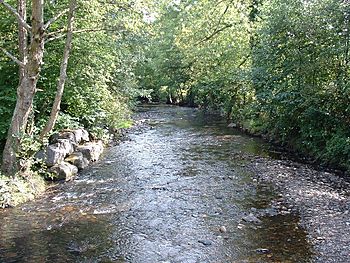River Llynfi facts for kids
Quick facts for kids River Llynfi |
|
|---|---|

River Llynfi. From the bridge at Pont Rhyd-y-cyff
|
|
| Native name | Afon Llynfi |
| Country | Wales |
| Cities | Blackmill, Brynmenyn |
| Physical characteristics | |
| Main source | Craig Ogwr |
| River mouth | Aberkenfig |
| Basin features | |
| Tributaries |
|
The River Llynfi, known as Afon Llynfi in Welsh, is an important river in Wales. It is one of three main rivers that flow into the River Ogmore. A tributary is a smaller river or stream that flows into a larger river.
The Llynfi starts its journey north of Maesteg. It then flows generally southwards through the Llynfi Valley. It travels about 10 miles before reaching its end. Finally, it meets the River Ogmore and the River Garw at a place called Aberkenfig. This meeting point is called a confluence.
Contents
The River Llynfi's Path
The River Llynfi begins its journey near Maesteg. From there, it flows south through a valley named after it, the Llynfi Valley. Along its way, several smaller streams join the river.
Streams Joining the Llynfi
The Llynfi has many smaller streams that feed into it. These streams add to the river's flow.
- On its left side, two streams join:
- Nant Cwm-du
- Nant Cedfyw
- On its right side, three other streams join:
- Nant Crynwydd
- Nant Sychbant
- Nant y Gadlys
The River's Past and Present
For a long time, the Llynfi Valley was a busy industrial area. There were many factories and mines, especially around Maesteg. This included places where iron was made and bricks were produced in a town called Tondu.
How Industry Affected the River
In the past, these industries caused a lot of pollution in the river. Waste from factories and mines, along with poor sewage systems, made the water very dirty. This meant that very few plants or animals could live in the river. It was almost abiotic, meaning it had no life.
A Cleaner Future
Luckily, things have changed a lot. In the second half of the 20th century, coal mining slowed down. New rules and strong actions against polluting industries helped a lot. This led to a steady improvement in the river's water quality.
Today, the River Llynfi is much cleaner. This allows more plants and animals to live in and around its waters. It shows how much a river can recover when people work together to protect it.

